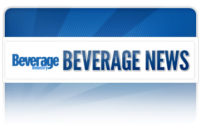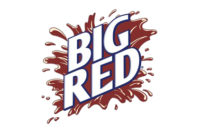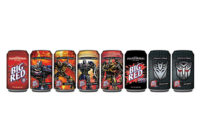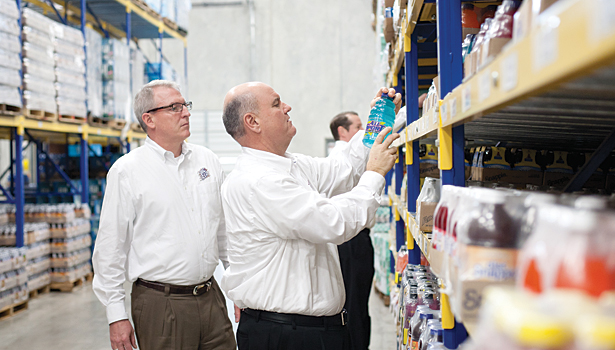Big future in store for Big Red
Beverage-maker ramps up expansion of flavored CSDs

From left: Big Red Inc.’s Thomas Oh, senior vice president of marketing; Steve Nelson, senior vice president of sales; Gary Smith, chief executive officer; Scott Jackson, vice president of supply chain; and James Bradley, chief financial officer, gather at 7UP/RC Cola/Big Red of South Texas’ warehouse in Austin, Texas.

From left: Big Red Inc.’s Scott Jackson, vice president of supply chain, and Steve Nelson, senior vice president of sales, examine All Sport products at the 7UP/RC Cola/Big Red of South Texas’ Austin facility

Big Red Inc. Chief Executive Officer Gary Smith explains to Beverage Industry’s Managing Editor Jessica Jacobsen the influences behind the company’s latest innovation: Big Red Zero, a zero-calorie soft drink that was designed to taste similar to the brand’s full-calorie offering.

Big Red Inc. designed Big Red Zero to help improve the company’s volume sales of its diet segment.




With a company history as vibrant as its flagship brand, Big Red Inc., Austin, Texas, is ramping up its efforts in 2012 to expand its Big Red brand throughout the United States as well as to honor the loyalty of those who have enjoyed the flavored carbonated soft drink (CSD) throughout the brand’s 75-year history.
“Big Red is a great brand,” says Chief Executive Officer Gary Smith. “People who drink it are super loyal and passionate about the brand.”
That loyalty was part of the inspiration for Smith’s choice to purchase the company in 2007 with funding raised through Citigroup. “It is a very well-respected company in Texas,” he says. “Being from Texas and living in Texas, it was inspiring to purchase a truly authentic Texas brand.”
Smith’s acquisition of Big Red was not his first entry into the beverage marketplace. After graduate school, he worked within the Pepsi system for 15 years and then was the co-chief executive officer at Red Bull North America before purchasing the All Sport sports drink brand, which was followed by the acquisition of Big Red Inc.
As the sixth largest soft drink company in the United States, Smith says, he and his management team continue to use their industry experience to expand the Big Red brand as well as the additional brands in the company’s portfolio.
Big expansion
Although Big Red has established itself in Texas, the flavorful soft drink also has a strong presence outside of the Lone Star State in places such as Louisville, Ky., and southern Indiana — markets where the brand has been in distribution for decades. Recently, Smith and his team set out to place the product in every zip code in the United States.
“[Big Red] is a big deal in Texas,” Smith says. “What we set out to do is expand Big Red from Texas to the rest of the U.S. and then see if it resonates with consumers outside of the U.S.”
Currently, Big Red is available in 43 states, says Senior Vice President of Sales Steve Nelson. The areas where it is not yet available are Hawaii and parts of the East Coast.
“We’re not in those [East Coast] areas right now, but we’re working diligently with some independent Pepsi bottlers and Pepsi Beverages Co. to fill that area with Big Red,” he says. “I think with the multicultural population growth that’s happening in that area and the way [flavored CSDs] are expanding and growing, they see the value of Big Red being a part of their portfolio.”
The expansion process complements the transition of the company from a concentrate-only production format to a platform that provides concentrate and finished beverages.
“If you look at Big Red three or four years ago, you would have seen a predominantly concentrate business model: manufacture the concentrate, sell it to the bottlers, the bottlers manufacture it, convert it into full goods and distribute it into the market,” says Scott Jackson, Big Red Inc.’s vice president of supply chain. “When you look at Big Red today, it is still a concentrate business, but a third of the business is full goods manufacturing and distribution. We’re much more of a full-service beverage company on the soft drinks side than we were three or four years ago.”
Smith says that providing finished products has opened Big Red to more distributors because a number of distributors do not have access to bottling plants. Before, when Big Red dealt only in concentrate, the brand was not available to these companies, but now being a full portfolio beverage company can aid in Big Red’s expansion, he notes. Within the new business model, Big Red also offers supply chain services for the non-bottling distributors.
“We’ll connect that non-producing distributor with a producing facility, and in some cases we’ll actually process their order, secure product for them, and handle distribution to their facility for them to deliver to retailers,” Jackson says. “We don’t do that for a lot of folks, but we provide that as a service.”
Although the CSD market has experienced some contraction in the last couple of years, not all entities have suffered. “It’s getting harder and harder with the way the industry has shrunk,” Nelson says. “It makes it more difficult to find space with some of the other liquid refreshment beverages growing at a faster rate than CSDs.”
Despite the overall category’s declining rate, the Big Red brand has reported year-over-year increases, Nelson says.
“If you look at Big Red, we’ve done better than most of our peers,” he explains. “I believe Dr Pepper has outpaced the industry four years in a row; we’ve done it for seven years in a row. It’s been a tough, competitive category, but it’s finding that space in the retailer that’s the most valuable and a lot of that’s got to do with the strength of your franchisee.”
Smith adds that he credits the company’s key franchisees, distributors and bottlers as well as its partnership with Dr Pepper Snapple Group (DPS) for helping to expose and expand the soft drink brand beyond Texas retailers and into the rest of the nation. DPS strengthened its relationship with Big Red Inc. in 2008 when the companies reached an agreement for DPS to acquire a minority stake in Big Red Inc.
“[DPS employees] are all huge supporters of Big Red,” Smith says. “They recognize the importance of Big Red in their portfolio and have done a tremendous job at helping to expand the brand and promote the brand, [which] are the reasons for the success of Big Red’s consistent volume growth and consumer loyalty in our core markets.”
DPS also recognizes the strength of its partnership with Big Red Inc. “Great brands with great flavor variety are what defines the Dr Pepper Snapple Group portfolio, and that extends to the allied brands that we carry in our [direct store distribution] system,” says Rodger Collins, president of packaged beverages for DPS. “Big Red is a key anchor of our allied brand lineup. Not only are their products a natural complement to our flavor portfolio, but they are a fantastic partner to work with in all areas. We’re proud to play a role in the continued growth and success of their brands.”
Within its distribution model, DPS handles about 80 percent of Big Red’s franchise volume; Pepsi Beverages Co., PepsiCo’s North American bottling operations, has about 10 to 11 percent with the rest compiled through smaller independent distributors throughout the United States, Nelson says.
Beyond penetrating new markets, Nelson says that the company also is focusing on emerging markets where the products are already available. “We have a lot of work to do in areas outside of our core markets,” he says. “There’s still just a phenomenal amount of growth that we can do out of there.”
Building the brand
In addition to expanding the availability of Big Red, Smith and his team have made efforts to expose the brand to more consumers with new marketing initiatives. The company recently aired TV advertising for the first time in 25 years, and also executed out-of-home, online and radio spots that were based on the Big Red brand’s new platform: “Deliciously Different.”
Thomas Oh, senior vice president of marketing, says the company conducted extensive consumer research and engaged an agency to develop a marketing platform that it tested in both its core and emerging markets. The company’s campaign, “Tastes Good To Be Different,” launched in the summer of 2011.
“We updated the graphics to make it more current and then we landed on and started to communicate this whole idea of celebrating difference: our product is different — its vibrant red color and indescribably different flavor — and we celebrate people who are different,” he says. “We felt this was a platform that resonated universally with consumers and fit our brand to a tee given the product’s attributes.”
Big Red also is developing plans for the celebration of its 75th anniversary. Oh says the summer promotion will include the brand’s first-ever under-the-cap promotion where consumers can accumulate points to be redeemed for vintage Big Red memorabilia. “It will be a way for us to celebrate and reward our loyal consumers,” he says. “We’ll also have special pure cane sugar [sweetened] four-packs that we’ll put in the marketplace, especially in our core markets, to celebrate the anniversary.”
This past year, the company also strategically decided to use Big Red as the lead brand in its motor sports marketing strategy.
Optimizing the mix
With the Big Red brand repositioned, the company turned its attention to revamping its diet offering. When looking at Nielsen data, Diet Big Red was about 6.2 percent of the total Big Red trademark volume, Oh says. That number was severely underdeveloped compared to other flavored CSDs like Dr Pepper or 7UP, whose diet offerings can make up 30 percent of their volume. Plus, the company noted that Diet Big Red was declining during a time when people are more conscious about their calories and other diet CSDs were growing.
Smith recognized the critical need to address this issue, so the company turned to its research and development (R&D) department as well as guidance from strategic partner DPS.
“I remember sitting down with [the R&D department] and they gave us probably 30 different variants of optimized diet or zero-calorie drinks and they asked us in terms of strategy did we want a better diet or did we want to match closer to regular?” Oh says. “Since only 6 percent of our volume came from our current diet, we said that there was probably more of an opportunity to match our regular taste and attract new users, so that’s the strategy we took.”
Smith and his team then set out to its core markets, San Antonio and Louisville, Ky., to test six variants of optimized diets as well as its current diet. When it came to aroma, mouthfeel, flavor and carbonation, one variant scored the highest. That product became the brand’s new no-calorie option: Big Red Zero.
As important as it was to develop the right flavor for the new zero-calorie product, the team also set out to create a package that would appeal to diet drinkers. Oh says the company opted for black packaging because when testing black, white and silver variations, the black option resonated well among consumers, including females.
The company launched Big Red Zero with a marketing campaign under the tagline: “Introducing Nothing,” highlighting that the product contains zero calories while still maintaining the original Big Red flavor. The company took production samples to San Antonio and Louisville a few weeks before the official launch where it filmed a video with consumers’ reactions to tasting the product.
“The consumer feedback was just spot on; exactly what we wanted folks to say — that it didn’t have an aftertaste, it tasted more like Big Red than Diet Big Red and that they would switch over from Diet Big Red to Big Red Zero,” Oh says.
“Seeing how our customers reacted to [Big Red Zero], looking at some of the consumer insights work that’s been done around it, I can see that our Zero’s going to be a huge hit, so that’s really something that everybody here is excited about,” Smith says.
Sporting changes
Although the company has many plans in store for growing its Big Red portfolio, it also is developing plans for some of its other products, such as All Sport. In the ‘90s, All Sport made up 10 percent of the market share for sports drinks, says James Bradley, chief financial officer. Since then, those numbers have decreased.
“Our goal has always been to get back to 10 percent market share in 10 years,” he says. “We’re very long-term in how we view the business and our growth. We’re very determined to get there no matter how long it takes. Hopefully we’ll get there faster, but if it takes 10 years, it takes 10 years.”
In order to help the brand reach that 10 percent market share, the team will look to re-tool All Sport.
“We’re looking to reposition All Sport, really going after an underserved population in the sports drink realm,” Oh says. “There are all these occasions where people are drinking sports drinks beyond just athletics. They drink it with meals, they drink it to relax, in addition to drinking it to replenish after sports. With that insight, we engaged our agency to develop a new platform that targets the ‘every man’ [and] the ‘every woman.’ You don’t have to be an athlete to need the benefits of All Sport.”
The company plans to test new graphics and new positioning in select markets this year.
Growth opportunities abound
Beyond its namesake red soda, Big Red Inc. is a full beverage company with a varied portfolio. When Smith purchased Big Red Inc. in 2007, he also acquired the NuGrape and Nesbitt brands.
NuGrape, a grape CSD that was introduced in the 1920’s in Atlanta, became a popular grape soft drink in the southeastern states, Smith says. However, in the ‘80s and ‘90s, NuGrape found itself without a distribution partner. Likewise, Nesbitt was a popular orange drink in the ‘60s on the West Coast and in Canada, Smith says, but had faded in popularity.
Today, due to established orange and grape brands within other major distributors, Nesbitt and NuGrape have distribution models established through either independent distributors or a direct-to-store model, Smith says.
With the help of the company’s flavor house, Smith set out to make Nesbitt Orange the best-tasting orange-flavored soft drink on the market. “We took the orange flavoring and all the ingredients to a super-premium position and put it in a glass bottle,” he says.
Flavor reformulations are nothing new for the company since it started off as a flavor extraction house, Smith says. “We have a lab, we have all the equipment … and the history of being a flavor extraction house,” he says. “At one time, we made vanilla extract.”
The flavor house has allowed the company to manufacture its own flavor systems for its many brands. And last year, the company conceived and launched SANS Soda as an all-natural diet soda alternative. Although SANS, a stevia-sweetened soft drink, remains a small segment currently, the company is excited to have an entry in the emerging natural soft drink market, Smith says.
In October 2011, Big Red Inc. purchased Portland, Ore.-based Thomas Kemper Soda Co., a maker of vintage and all-natural varieties of craft-brewed sodas.
“When opportunities come along like adding Thomas Kemper, an iconic Pacific Northwest brand, to our portfolio, we’re definitely going to look at it,” Bradley says. “And in this case, we’re very happy with the results. Thomas Kemper is doing really well and it’s amazing how much demand there is for their products.”
Smith says part of the motivation for the purchase of Thomas Kemper was that the company wanted to add a craft root beer to its portfolio to go along with its glass bottled offerings of Nesbitt, NuGrape and Big Red Retro, a pure cane sugar-sweetened CSD. “Our goal is to put four-pack carriers of Nesbitt, NuGrape, Big Red pure sugar and Thomas Kemper out in every grocery specialty set,” he says.
Although Big Red remains the focus of Big Red Inc., Smith says the smaller brands still have their place within the beverage marketplace.
“Big Red is who we are and the Big Red brand is where we focus most of our time, energy and effort, but we’re excited about building a total beverage company,” Smith says. “We offer our consumers and retail partners a varied portfolio of products. We’re having a lot of fun growing our existing, iconic business and we’re always looking for new, emerging growth opportunities.” BI
Looking for a reprint of this article?
From high-res PDFs to custom plaques, order your copy today!












